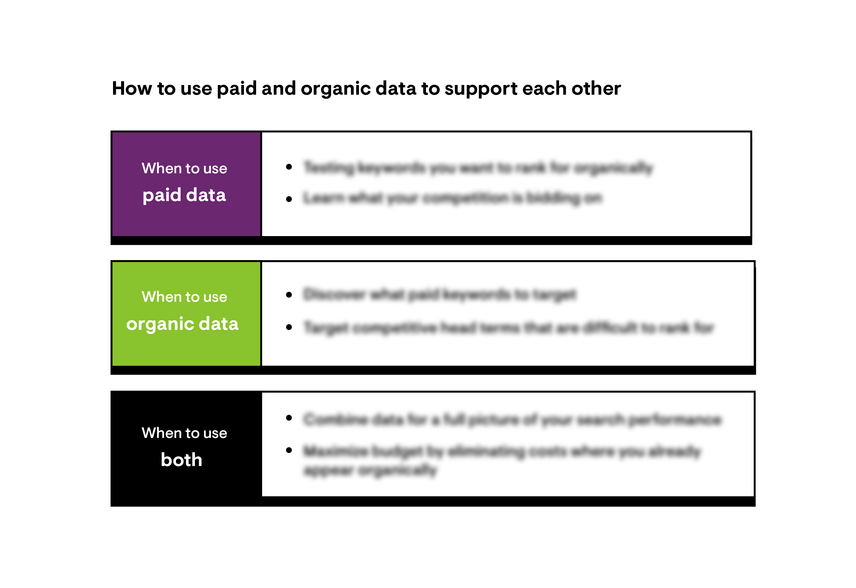8 Ways to Maximize Brand Awareness Through Paid and Organic Search
Brand awareness is the measure of how memorable and recognizable your brand is to its target audience. Effective brand awareness turns a single Google search into a customer acquisition opportunity.
You can maximize brand awareness by leveraging the accessible data from your paid and organic search strategies to make them more effective. Achieve this by developing a strong SEO foundation, breaking down silos between teams, combining data, and analyzing user behaviors.
In the early days of marketing , consumers were captive. Bombarded with TV, radio, and billboard ads, potential customers had little say in how they discovered brands.
Today, consumers are empowered to educate themselves. While they still receive ads on traditional mediums, they increasingly seek solutions online. A full 87% of shoppers in the U.S. begin product searches online, with a majority turning to Google to find the answers they need. The path to purchase is non-linear, with multiple touches occurring across channels, devices, and locations. Consumers want to research, reflect, and compare their options before making a decision.
Providing potential customers with helpful content throughout this journey is the best way to build trust. 54% of consumers say they trust websites more that appear at the top of the search engineSearch Engine
A search engine is a website through which users can search internet content.
Learn more results pages (SERPs). Ranking highly on Google is the best way to build brand awareness, generate leads, increase revenue, and provide genuine value to your customers.
Before we dive into concrete strategies on how to improve brand awareness through paid and organic search, let’s get started with the key terms to know about brand awareness and search marketing.
What is organic search?
Online search engines and algorithms are designed to crawl the web and deliver efficient answers to relevant search terms. Organic results cannot be paid for—they are solely the result of which content or websiteWebsite
A website is a collection of HTML documents that can be called up as individual webpages via one URL on the web with a client such as a browser.
Learn more pagePage
See Websites
Learn more the algorithm deems most relevant and helpful for the given search termSearch Term
A search term is what users key into a search engine when they want to find something specific.
Learn more. Historically, organic results on Google appeared on SERPs as lists of blue links. More recently, Google has been incorporating a variety of result types, such as featured snippetsFeatured Snippets
Featured snippets are highlighted excerpts of text that appear at the top of a Google search results page in what is known as ‘Position 0’.
Learn more, People Also Ask, and shopping, that pull website content directly onto SERPs so users can find the answers without leaving the page. Result types are still considered organic because they cannot be purchased.
Search engine optimization (SEO) is the way that marketers strategize to rank highly for relevant terms organically. SEO is valuable because of its relatively low barrier to entry and the high return on investment over time. Companies can rank well by providing genuine value to customers and ensuring that search engines can easily understand the content on your site. Consumers overwhelmingly click on organic results over paid ones , resulting from a higher level of trust and a feeling that they’re in control of their search experience.
What is paid search?
Most search engines make money by displaying paid ads alongside organic results on SERPs. Pay-per-click (PPC, or paid search) is the type of marketing in which advertisers pay a search engine each time their ad is clicked. PPC results are identified as ads and typically appear above and below organic results on SERPs.
Paid search can be complex, with a bidding process in which prices fluctuate based on the market. Some companies outsource their paid marketing entirely, while others boast in-house teams with dedicated headcount and technology. PPC is a useful channel because it is a predictable source of traffic and provides immediate, short-term wins, as long as the price you pay per click is less than the ultimate conversionConversion
Conversions are processes in online marketing that lead to a defined conclusion.
Learn more value of that traffic.
What is brand awareness?
Brand awareness is the measure of how memorable and recognizable your brand is to its target audience. It is crucial to drive awareness of your brand at each stage of the marketing funnel, from education to consideration to conversion. While brand awareness is generally associated with the top of the inbound marketing funnel, its importance isn’t limited to early-stage prospects. It also pays dividends down the line and helps fuel long-term growth, as customers are more likely to renew or re-purchase from a company that is top of mind.
Brand awareness is particularly important for B2B companies because of lengthy sales cycles and the presence of multiple decision-makers. It usually takes more than just one touch to close a sale. Memorable and valuable interactions with your brand will make a prospect more likely to purchase. Decision-makers also want control of the buying experience; B2B buyers are 147% more likely to buy when they self-navigate the purchase process.
There are multiple types of brand awareness. Unaided awareness is the most difficult and most beneficial to brands. Awareness is considered unaided when customers can recall a brand without being prompted. This means that your brand will be top of mind when it comes time to consider options and make a purchase. Aided awareness is simply awareness that comes after prompting. Customers that fall into this bucket have likely been exposed to your brand somewhere but haven’t yet solidified it in their minds. Finally, brand familiarity refers to the deepest level of knowledge and understanding about your brand. Such customers may even be brand advocates.
What is an example of brand awareness?
Glossier is one example of B2C brand awareness done right, with the brand’s initial viral success powered almost entirely by organic efforts. Prior to launching the brand, founder Emily Weiss generated a cult following by interviewing women about their skincare routine and makeup must-haves in her blog, Into the Gloss. Weiss used these insights to inform the content marketingContent Marketing
Content marketing is a marketing discipline with the goal of increasing awareness and scope for products and brands in the desired target group with content published on the web and offline.
Learn more strategy for the future cosmetics brand, eventually featuring detailed, visual content on how to use each product, along with more creative ways to use them.
Weiss also invested in building a comprehensive organic social strategy on platforms like Instagram before the brand even launched, developing the millennial pink aesthetic the brand eventually became synonymous with. Glossier also heavily relies on user-generated content as it regularly features this organic content across its social pages, incentivizing customers to become avid brand advocators online for a chance to be featured. These organic strategies helped catapult Glossier into competitionCompetition
Businesses generally know who their competitors are on the open market. But are they the same companies you need to fight to get the best placement for your website? Not necessarily!
Learn more with some of the biggest cosmetics brands by generating brand awareness (and brand loyalty) from the start.
Software company Asana provides an example of an effective B2B brand awareness strategy. The team at Asana identified that potential customers interested in developing a marketing strategy will likely also need project management software to run their program. As a result, Asana created a targeted piece of content called 19 Types of Marketing You Should Know About to:
- A) Provide genuine value to marketers and future customers
- B) Raise awareness about Asana to these potential early-funnel customers
This piece generates over 2,000 organic clicks in the U.S. every month and ranks in the first position on Page 1 for important keywords like “types of marketing.” Through this early-stage organic content creation, Asana increases brand awareness. The content helps the brand be front of mind when that searcher transitions to evaluating project management software solutions.
Paid vs. Organic: How to balance search strategies to maximize brand awareness
When it comes to paid and organic marketing, it’s not either/or but both. Achieving synergy between the two is about maximizing impact to grow and nurture your audience without wasting spend on places where you’re already visible. Finding the right balance is the challenge.
Sometimes it’s best to bid on paid keywords to improve visibility, while other times it’s more cost-effective to invest in organic content creation for keywords and phrases that are too expensive to bid on via PPC. A comprehensive strategy uses insights from paid search to inform organic search efforts and vice versa.
Here are eight concrete strategies to help you maximize—and even surpass—your brand awareness goals using paid and organic. Download the complete guide for a deeper dive on each strategy, along with tactical details on how to implement.
1. Start with a strong SEO foundation
A crucial first step to improving brand awareness on search is to develop a strong SEO foundation. Without a strong SEO foundation, you will completely rely on paid spend.
2. Identify areas of opportunity for paid search where you aren’t performing organically
PPC is a great way to generate brand awareness for terms you are not (yet) ranking for organically.
3. Test brand-related keywords in paid and organic search
Brand-related keywords directly contain the name(s) of your product or services. Paid search offers a valuable testing ground for organic brand-related keywords and vice versa.
4. Align your paid and organic marketing teams
Team alignment is key to maximizing your paid and organic search marketing budget. Siloed organic and PPC teams lead to duplicated efforts and inflated budgets.
5. Combine paid and organic data to inform strategies
The goal is to combine the two data sources to improve your brand’s visibility across your entire breadth of keywords. Download the complete guide for access to the insights below on when to use paid data, when to use organic data, and when to use both.

6. Target Google, but evaluate opportunities on other search engines
For many brands, SEO is synonymous with Google. This makes sense, as Google accounts for over 90% of searches worldwide . However, this varies significantly by country. Baidu dominates the search market in China, for example. Even within the U.S., engines like Bing account for almost 1B daily searches .
7. Invest in PPC for mobile and SEO for desktop
Search results differ drastically between mobile and desktop. Google recently moved to mobile-first indexing, reflecting the importance and predominance of mobile compared to desktop . Download the complete guide to learn why you should use PPC investments to target mobile searchers and organic content to target desktop users.
8. Power your paid campaigns with organic content
SEOs are sitting on a treasure trove of data that can provide insights for your paid strategy.
How to measure brand awareness strategies
It’s not enough to just implement the strategies described above. You’ll also need to evaluate whether those strategies were effective. This includes choosing the right metrics and reporting on them in a consistent and scalable way. Here are some of the top metrics for measuring brand awareness across a number of channels.

Once you’ve selected the metrics you want to use to measure brand awareness, you’ll want to develop actionable reporting mechanisms. This can range from simple—a monthly email to your CMO—to complex—automated reports sent from an enterprise SEO platform. Of course, your exact need will depend on the size of your operation and the available budget.
Recap: The best path to brand awareness
Whether you’re just getting started on your digital journey or have a seasoned brand presence, these helpful tips can help fuel your funnel and drive conversions.
Download the complete guide for step-by-step guidance on how to implement these eight strategies to maximize brand awareness and make your organic and paid spend go further.







